
Introduction
Ancient history
Modern history
Traditional operation
Open rhinoplasty
Template rhinoplasty
Alar base reduction
Septal surgery
Implants
Revisions
Cartilage grafts
Bone grafts
Problems
|
Septoplasty Surgery
It is uncommon for a patient to notice a slight nasal bend
when looking in a mirror. Photographs and the
image-reversing mirror will reveal the deviation. That is why
many of us do not like to have photographs taken. A person with a
more severely bent nose may complain of
blockage of the airway.
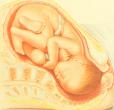 |
Nasal deviation is commonly due to
trauma before birth . One instance of trauma is due to humans having large heads. There
is a lot of pressure applied to a baby's nose up to 4 weeks
before birth (less time for second and subsequent children). The baby is born with a bent nose but this
deviation corrects itself over a few days because the
skeleton in the front of the nose is cartilage and it is
flexible. |
 |
| 20% of people have permanent
deviation of the septum caused by dislocation of the
septal cartilage (1) from the
vomer bone (2). The cartilage dislocates where
the red dotted line is seen in the figure that illustrates the
midline structures of the nose. |
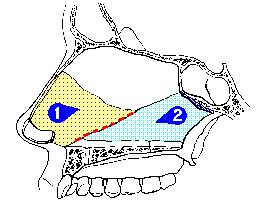
|
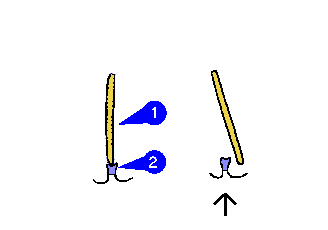
|
This form of nasal deviation is thought to be due to
pressure on the cheek bones that occurs
earlier in pregnancy. The Braxton Hicks contractions, also known as false labour, may be the cause. The pressure produces
compression of the upper jaw and the roof of the mouth moves
higher. The roof of the mouth is also the floor of the nose so
the vomer pushes upwards and the septal
cartilage is forced off it. The scene is now set for
nasal problems that include excessive growth of the nose
at puberty. |
| Damage to the vomer (2) during the dislocation produces a
thickening of the bone called a spur (3).
Deviation of the septal cartilage (1) produces a widening
of one nasal passage and the turbinate
(4) on that side enlarges. Paradoxically, it is
on this wide side that the nose often feels
blocked. The large turbinate causes the
problem. |
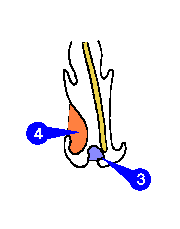
|
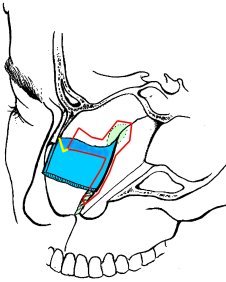 |
SEPTOPLASTY and S.M.R.
(submucous resection) are names for operations that improve the
midline structures inside the nose. We often do them with
rhinoplasties particularly if the nose is bent to one side.
Straightening a septum can help a blocked airway. The
straightening is partial as not all bends and thickenings will be
corrected.
Paul O'Keeffe modified the septoplasty technique at the
beginning of 2001 to include a safe chondrotomy
(cartilage cut) shown as yellow lines on the figure. This has
greatly improved the septum-straightening results without the
previously feared septal collapse that might occur after a
different chondrotomy.
Septal bone is often thickened where coloured green in the
figure. It is called a spur and would be removed at septoplasty.
(NB the caudal end of the septal cartilage is broken away in the
figure to show its dislocation off the vomer bone.)
|
| Septal reconstruction by suturing a bone
graft to the septal cartilage and setting it on one side of the
vomer produces additional stability of the structures. This is
another innovation by Paul O'Keeffe. |
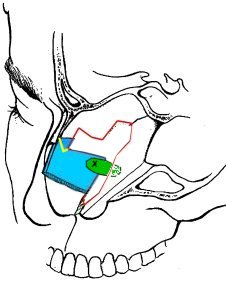 |
| TURBINATES (superior, middle and inferior)
are structures deep in the nose that look like swellings attached
to the side walls. They secrete mucus and can swell or shrink to
affect the size of the nasal passages. When the septum is
deviated to one side the inferior turbinate (4)
on the opposite side will often become too large
and frequently block the passage. The turbinate
is commonly reduced in size by a turbinectomy
operation. As with any operation, this can be done simply and
quickly or carefully and in a more conservative way. Simply
cutting the inferior turbinate off might remove too much tissue
and lead to a dry nose. It is better to remove a small amount of
mucous membrane and then reduce the the thick part of the bone
underneath the membrane. |
 |
Back to Top
|




